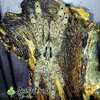- Joined
- Sep 17, 2009
- Messages
- 68
This is Debbie Harry, a Desert Blonde Tarantula that is part of the breeding team here at Josh’s Frogs. The scientific name of this species, Aphonopelma chalcodes, is derived from the roots “aphono-” meaning without sound, “-pelma” meaning foot, and “chalco-” meaning copper or bronze, a reference to the coloration of this tarantula's hairs. While this species can sometimes be quite tolerant, Debbie is a spitfire who tolerates no shenanigans in her habitat. In this picture, Debbie is raising her abdomen high in the air striking an intimidation pose commonly used by many species that share her genus, Aphonopelma.















